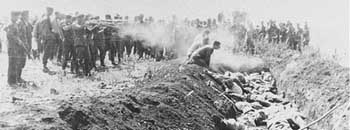
Funeral of inmates who died or were killed just prior to liberation
The Nazis did not start World War II with a plan to eliminate the Jews. This solution evolved—especially from 1939 to 1941—as they tried different techniques to accomplish their goals. Particularly in Germany and Poland camp commandants experimented with various killing methodologies and consulted with one another on their successes and failures. The ability of a single camp to kill 2,000-3,000 people per hour took years to achieve. At first, though, murder was done at close range-man-to-man, woman, or child.
Death by Firing Squad
In 1941, SS General Erich von dem Bach-Zelewski told his superior Heinrich Himmler that the Nazis had been murdering Jews, including women and children, at close range and in cold blood all summer. Bach-Zelewski was worried about this method's traumatizing effects on his men. Himmler recorded in his diary the General's concerns: "And he said to me, 'Reichsfuhrer, these men are finished for the rest of their lives. What kind of followers are we producing here- either neurotics or brutes?'"

Einsatzgruppen killing
Himmler realized he had to find new methods that would spare his troops the psychological strain of killing human beings at close range.
Carbon Monoxide
According to the memoirs of Rudolf Hss, Commandant of Auschwitz, Adolf Eichmann suggested using "showers of carbon monoxide while bathing, as was done with mental patients in some places in the Reich." Instead of leading to water, the showerheads were connected to canisters of carbon monoxide.
The birth of this method had varied sources, including one ironic twist. Artur Nebe, a Nazi-killing squad commander, had come home drunk from a party one night and passed out in his garage with his car still running. The carbon monoxide gas from the exhaust nearly killed him.

The first carbon monoxide experiments, done with cars
As Nebe related the incident to his SS comrades, this near-miss convinced him that gassing could be used effectively against the Jews and other Nazi enemies. Gas would be cheaper than bullets, and no Nazi would directly take a life.
Hell Vans
The Nazis' experimented with another methodology using carbon monoxide. Deported Jews from the Lodz Ghetto were led through a basement corridor and then up a ramp to a small windowless room that turned out to be the cargo area of a large van. Once the van was full, the doors were slammed shut, and as it was driven to a nearby forest, exhaust fumes were routed into the back, asphyxiating the trapped victims.

A hell van (recreation)
After the van reached its destination, the bodies were buried or burned. Zofia Szalek, a German residing in the Polish town of Chelmno, describes what she witnessed: "We could hear the screams, but we couldn't see the people. They were loaded in and murdered there. It was hell. That's why we called these vans 'Hell Vans.'"
Zyklon B
The most effective and efficient technique developed for killing at Auschwitz depended on the same pesticide that was used to kill the lice in prisoners' clothing. The disinfectant, sold under the trade name of Zyklon B, was in plentiful supply. Once exposed to properly heated air, the crystals produced lethal gas.

Canister labels, Zyklon B
In the fall of 1941, the basement of cell block 11—the Auschwitz building where some of the most despicable punishments were meted out—was sealed and locked down. August Kowalczyk, a Polish political prisoner on a nearby work detail, witnessed the entire event. He reports that because they were still experimenting, Nazi judgments in error caused the murders to take place over a two-day period, instead of the expected half hour.
Massive Gas Chambers and Crematoria
By the early spring of 1943, four huge crematoria became fully operational at Auschwitz II (Birkenau). They housed eight gas chambers and forty-six ovens that could dispose of some 4,400 corpses per day. Trains would arrive at the camp and those most fit—approximately 10-30 percent of the arrivals—would be selected for a work detail. The remaining prisoners were sent to the gas chambers.
Prisoners assigned to a unit known as the Sonderkommando had to move the bodies from the gas chambers to the furnaces. Several bodies at a time were burned in a single oven. In May 1944 a serious bottle-neck occurred at Auschwitz, because the deportation and extermination of the Hungarian Jews was under way.

Auschwitz gas chamber (artist's rendition from original documents)
Numbering about 725,000, plus thousands more who were Christian converts but still counted as Jews by Nazi racial criteria, the Hungarian Jews were the largest Jewish group that remained alive in Nazi-dominated Europe. Between late April and early July 1944, more than 380,000 of them were brought to Auschwitz-Birkenau, where most were gassed and cremated. When the demand for corpse disposal overtaxed the camp’s ovens, camp authorities, needing to speed up the process, again resorted to burning bodies on pyres, using the huge pits that had been dug behind Crematorium V.
Precise counts of how many people actually were murdered in death camps can never be made because those marched off directly from the trains usually were not registered. However, a calculation that is both conservative and reliable indicates that at least 1.1 million people were gassed to death at Auschwitz—90 percent of them Jews.
Even with all of the death technology, the Germans could not cremate everyone they murdered during the Holocaust. As they retreated from the advancing Allied forces, they blew up the gas chambers and crematoria to destroy the evidence at Auschwitz. But the evidence lingered. In camps throughout Poland and Germany, tens of thousands of bodies remained stacked or spilling out into the cold winter snow.
ncG1vNJzZmivp6x7sa7SZ6arn1%2BWwrSvx7CgrbJfaX1ugJRooqKknJ67qHs%3D